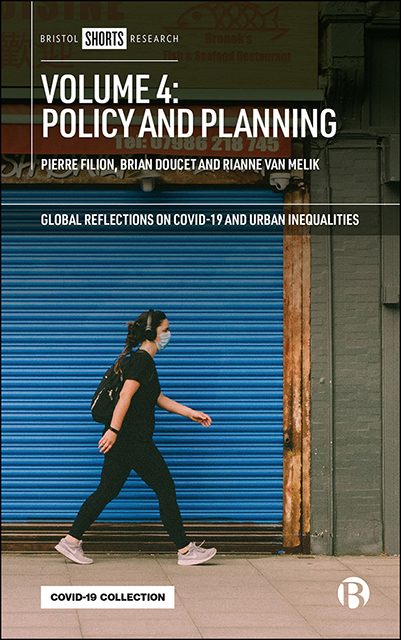Book contents
- Frontmatter
- Contents
- List of Figures and Tables
- Notes on Contributors
- Acknowledgments
- Preface to All Four Volumes of Global Reflections on COVID-19 and Urban Inequalities
- One Introduction: Policy Making in the Face of Uncertainty and Inequality
- Part I COVID-19 and Urban Changes
- Part II The Pandemic, Social Inequality, and Mobilization
- Part III Municipal and Urban Policy Responses
- Index
Eighteen - Urban Regional Planning under the Pandemic: The Case of Oslo
Published online by Cambridge University Press: 25 April 2023
- Frontmatter
- Contents
- List of Figures and Tables
- Notes on Contributors
- Acknowledgments
- Preface to All Four Volumes of Global Reflections on COVID-19 and Urban Inequalities
- One Introduction: Policy Making in the Face of Uncertainty and Inequality
- Part I COVID-19 and Urban Changes
- Part II The Pandemic, Social Inequality, and Mobilization
- Part III Municipal and Urban Policy Responses
- Index
Summary
Introduction
COVID-19 presents our most serious global health threat in over a century. Unprecedented mobility restrictions have become a foremost means around the world to suppress COVID-19 mortality and relieve health care demand. Even though the pandemic is a global phenomenon, the economic, health and social implications of the virus are highly differentiated geographically and societally. This is due to the location of outbreaks and transnational mobility, but also to countries’, places’, and people's coping capabilities and societal capacities to deal with the pandemic. There has been a strong focus on the differences between countries, with travel bans, disruptions affecting supply chains, transportation, and the functioning of international trade and tourism, as well as on changes in the attractiveness of cities and hinterlands, fueled for instance by the temporary exodus of residents from high-rent places like New York City (Ruiz, 2020). In contrast, differences in COVID-19 vulnerability within cities have received much less attention. This is remarkable given that urbanization, income, health, and mobility inequalities, digital divides and the uneven access to reliable information flows have produced parallel vulnerabilities within cities, which are now intersecting with and amplifying the impacts of COVID-19. As such, the pandemic itself, the confinement interventions, and their joint societal impacts intersect strongly with urban, regional, and transport planning: that is, the location and form of housing, workplaces, services, and amenities, as well as the social and physical infrastructures that have determining effects on people's everyday life.
In this chapter we explore the intraurban geographies of epidemic vulnerability in the Norwegian capital Oslo, and investigate how these intersect with urban form, public transport habits, and pre-existing inequalities in socio-economic status, health background, and the housing situation. Drawing on this knowledge, we provide a discussion on the epidemic vulnerabilities and accessibility inequalities as well as the sustainability and health benefits of the dominant planning paradigms in this region, which, as in many other urban regions (most notably in Europe) concentrate on densification and transitoriented nodal development. By doing so we aim to provide recommendations to integrate health and epidemic resilience into sustainable and socially inclusive city-regions.
- Type
- Chapter
- Information
- Volume 4: Policy and Planning , pp. 189 - 200Publisher: Bristol University PressPrint publication year: 2021
- 1
- Cited by



